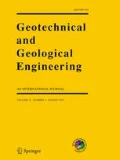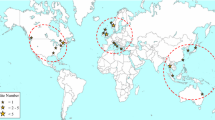Abstract
Empirical correlations provide valuable information in early design stages, and they help to validate or discard single values from site investigations. This paper presents a multivariate database from commercial projects consisting of evaluated shear strengths obtained from direct simple shear tests and fall cone tests (which are calibrated to the field vane test), including index tests. The multivariate database is used to investigate the performance of common transformation models and to test the recommended correction for fall cone tests. It is found that the measured normalised shear strength evaluated from direct simple shear tests and fall cone tests is correlated to the liquid limit and that the results conform to Swedish and Norwegian recommendations. However, the scatter is large, more for fall cone tests than for direct simple shear tests, which is thought to depend mainly on sample disturbance. It can however be concluded that the trend of normalised shear strengths increases with increasing plasticity.




Similar content being viewed by others
References
Ang AHS, Tang WH (2007) Probability concepts in engineering: emphasis on applications to civil and environmental engineering, 2nd edn. Wiley, New York
Bjerrum L (1954) Geotechnical properties of Norwegian marine clays. Géotechnique 4:49–69. https://doi.org/10.1680/geot.1954.4.2.49
Bjerrum L (1972) Embankments on soft ground. Proceedings of the ASCE Conference on Performance of Earth and Earth-Supported Structures, Purdue University, West Lafayette, Indiana 2:1–54
Bjerrum L (1973) Problems of soil mechanics and construction on soft clays. In Proceedings of the 8th international conference on soil mechanics and foundation engineering, Moscow. vol 3, pp 111–159
Cadling L, Odenstad S (1950) The vane borer - an apparatus for determining the shear strength of clay soils directly in the ground. In: Proceedings of the royal Swedish geotechnical institute. Royal Swedish Geotechnical Institute, Stockholm, Sweden, pp 1–88
Ching J, Phoon KK (2014) Correlations among some clay parameters—the multivariate distribution. Can Geotech J 51:686–704. https://doi.org/10.1139/cgj-2013-0353
Christensen S (2014) Tolkning av feltundersøkelser. In: Valg av design cuA - profil basert på felt- og laboratorieundersøkelser, Norway's water resources and energy directorate in cooperation with the Norwegian road and railway administrations report no. 77/2014, Trondheim
Cotecchia F, Chandler RJ (2000) A general framework for the mechanical behaviour of clays. Géotechnique 50:431–447. https://doi.org/10.1680/geot.2000.50.4.431
D’Ignazio M, Phoon KK, Tan SA, Länsivaara TT (2016) Correlations for undrained shear strength of Finnish soft clays. Can Geotech J 53:1628–1645https://doi.org/10.1139/cgj-2016-0037
D’Ignazio M, Phoon KK, Tan SA, Länsivaara T, Lacasse S (2017) Reply to the discussion by Mesri and Wang on “correlations for undrained shear strength of finnish soft clays. Can Geotech J 54:749–753.https://doi.org/10.1139/cgj-2017-0114
DeGroot D, Lunne T, Tjelta T (2010) Recommended best practice for geotechnical site characterisation of cohesive offshore sediments. In: Gourvenec S, White D (eds) Proceedings of the 2nd international symposium on Frontiers in offshore geotechnics. Taylor & Francis Group, Perth, pp 33–57
Graham J (1979) Embankment stability on anisotropic soft clays. Can Geotech J 16:295–308. https://doi.org/10.1139/t79-031
Hansbo S (1957) A new approach to the determination of the shear strength of clay by the fall-cone test. In: Proceedings of the royal Swedish geotechnical institute, Royal Swedish Geotechnical Institute, Stockholm, pp 1–47
Hov S, Holmén M (2018) The liquid limit [In Swedish]. Swedish Geotechnical Society Note 1. Linköping
Jamiolkowski M, Ladd CC, Germain JT, Lancellotta R (1985) New developments in field and laboratory testing of soils. In: Proceedings of the 11th International conference on soil mechanics and foundation engineering. August Aimé Balkema, San Francisco, CA, pp 57–153
Jardine RJ, Hight DW (1987) The behaviour and analysis of embankments on soft clay. Bulletin of the public works research centre special publication. Ministry of Environment, Physical Planning and Pub, Athens, pp 159–244
Kallstenius T (1963) Mechanical disturbances in clay samples taken with piston samplers. In: Proceedings of the Royal Swedish geotechnical institute. Royal Swedish Geotechnical Institute, Stockholm, Sweden, pp 1–75
Karlsrud K, Hernandez-Martinez FG (2013) Strength and deformation properties of Norwegian clays from laboratory tests on high-quality block samples. Can Geotech J 50(12):1273–1293. https://doi.org/10.1139/cgj-2013-0298
Karlsson R, Viberg L (1967) Ratio of c/p' in relation to liquid limit and plasticity index with special reference to Swedish clays. In: Proceedings of the conference on shear strength properties of natural soils and rocks. Norwegian Geotechnical Institute, Oslo, pp 43–47
Lacasse S, Berre T, Lefevbre G (1985) Block sampling of sensitive clays. In: Proceedings of the 11th conference on soil mechanics and foundation engineering. AA Balkema, San Francisco, CA, pp 887–892
Ladd CC, Foott R (1974) New design procedure for stability of soft clays. J Geotech Eng Div 100:763–786. https://doi.org/10.1016/0148-9062(74)90494-X
Larsson R (1980) Undrained shear strength in stability calculation of embankments and foundations on soft clays. Can Geotech J 17:591–602. https://doi.org/10.1139/t80-066
Larsson R, Bergdahl U, Eriksson L (1987) Evaluation of shear strength in cohesive soils with special reference to Swedish practice and experience. Geotech Test J 10:105–112. https://doi.org/10.1520/gtj10942j
Larsson R, Sällfors G, Bengtsson PE, Alen C, Bergdahl U, Eriksson L (2007) Shear strength: evaluation in cohesion soil. Swedish geotechnical institute information, Linkoping
Leroueil S, Tavenas F, Le Bihan JP (1983) Propriétés caractéristiques des argiles de l’est du Canada. Can Geotech J 20:681–705
Lundin SE (2000) Geotechnics in Sweden 1920–1945. Swedish geotechnical society report 1. Swedish Geotechnical Society, Linköping
Lunne T, Berre T, Strandvik S (1997) Sample disturbance effects in soft low plastic Norwegian clay. In Proceedings of the conference on recent developments in soil and pavement mechanics, Rio de Janeiro, June 1997, pp. 81–102.
Mayne PW (1988) Determining OCR in clays from laboratory strength. J Geotech Eng 114:76–92. https://doi.org/10.1061/(asce)0733-9410(1988)114:1(76)
Mayne PW, Mitchell JK (1988) Profiling of overconsolidation ratio in clays by field vane. Can Geotech J 25:526–544. https://doi.org/10.1139/t88-015
Mesri G (1975) Discussion on “new design procedure for stability of soft clays.” J Geotech Eng Div ASCE 101:409–412
Mesri G (1989) A reevaluation of using laboratory shear tests. Can Geotech J 26:162–164. https://doi.org/10.1139/t89-017
Mesri G, Wang C (2017) Discussion of “correlations for undrained shear strength of Finnish soft clays.” Can Geotech J 54:745–748. https://doi.org/10.1139/cgj-2016-0686
Olsson J (1921) Method of studying clay strength properties applied at the states railways [In Swedish]. Geol Assoc Negotiat 43:1
Sällfors G (1975) Preconsolidation pressure of soft, high-plastic clays. Ph.D. Thesis. Chalmers University of Technology
Sällfors G, Larsson R (2016) Determination of undrained shear strength with specialized methods in practical applications - compilation of case records. Swedish transport administration report 2017:037. Swedish Transport Administration, Gothenburg
Skempton, AW (1954) Discussion of the structure of inorganic soil. ASCE Proceedings 80, Separate No. 478, pp 19–22
Swedish Geotechnical Institute (1969) Reduction in shear strength with reference to liquid limit and sulphide content. In: Summary from technical meeting 11th December 1969. Stockholm
Tang WH (1980) Bayesian Frequency Analysis. J Hydraul Div 106(7):1203–1218
Thakur V, Fauskerud OA, Gjelsvik V, Christensen S, Oset F, Nordal S et al (2016) A procedure for the assessment of the undrained shear strength profile of soft clays. Proceeding of the 17th nordic geotechnical meeting on challenges in nordic geotechnic. Icelandic Geotechnical Society, Reykavik, pp 533–545
Thakur V, Gjelsvik V, Fauskerud OA, Christensen S, Oset F, Viklund M et al (2017) Recommended practice for the use of strength anisotropy factors in stability calculations. In: Thakur V, L’Heureux JS, Locat A (eds) Landslides in sensitive clays: from research to implementation. Springer, Cham, pp 249–258
Trak B, Rochelle PL, Tavenas F, Leroueil S, Roy M (1980) A new approach to the stability analysis of embankments on sensitive clays. Can Geotech J 17:526–544. https://doi.org/10.1139/t80-061
Acknowledgement
The authors are thankful to Dr. Jean-Sébastien L'Heureux at the Norwegian Geotechnical Institute, and the reviewer, for revising the manuscript and giving constructive comments.
Funding
The writing of this manuscript was partly funded by Tyréns AB, GeoMind/LabMind and KTH Royal Institute of Technology.
Author information
Authors and Affiliations
Contributions
Collection of data and first analyses was mainly performed within a Master’s thesis by Erik Persson. The thesis work was supervised by Sölve Hov and Stefan Larsson. Additional statistical analyses were performed by Anders Prästings. This manuscript was mainly written by Sölve Hov and Anders Prästings. Stefan Larsson reviewed the manuscript.
Corresponding author
Ethics declarations
Conflict of interest
The authors declare that they have no conflict of interest.
Additional information
Publisher's Note
Springer Nature remains neutral with regard to jurisdictional claims in published maps and institutional affiliations.
Rights and permissions
About this article
Cite this article
Hov, S., Prästings, A., Persson, E. et al. On Empirical Correlations for Normalised Shear Strengths from Fall Cone and Direct Simple Shear Tests in Soft Swedish Clays. Geotech Geol Eng 39, 4843–4854 (2021). https://doi.org/10.1007/s10706-021-01797-w
Received:
Accepted:
Published:
Issue Date:
DOI: https://doi.org/10.1007/s10706-021-01797-w




